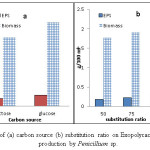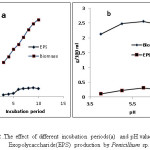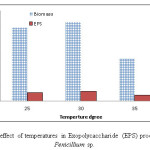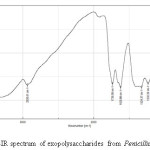Introduction
In the last few years, much more interest there has been a growing in extracellular polysaccharides production, especially from microorganisms, it has attracted the interest of the many researchers attributed to their industrial importance in varied food and bio-applications, Microbial exo-polysaccharides (EPSs) generally consist of monosaccharides units joined by glycosidic bonds and some non-carbohydrate substituents and its was produced by both prokaryotes and eukaryotes which are rich sources of enzymes, are also being intensively investigated as a permanent source of polysaccharides for industrial applications.1 Xanthan was produced from Xanthomonas2 Gellan from Sphingomonas paucimobilis Also produced from fungi such as Auerobasidium pullulans4 Saccharomyces cerevisiae5 Penicillium6 Fusarium7 Aspergillus.8,9 The fungi are often dispersed in the media of growth while some are linked to the cell wall which are either part of fungal cell wall or excreted extracellularly to play roles in cell protection or attachment to surfaces.10 Exopolysaccharides have been isolated from fungi as an active secondary metabolite and occurs as a fixation system to the substrate, and some of them may have biological activities or pathogenic effects over the host.11 The fungi of Ascomycota and Basidiomycota produced a maximal yield of Exopolysaccharides reached to 42.24 g l-1, This depended mainly on the culture conditions and type of strain.12 These EPSs have been used for biomedical applications and it is widely used as an additive in the food industry, and as a rheology modifier: it is used for thickening, stabilizing, emulsifiers, gelling agent, bioadhesives and antioxidants.13,14
The present study aimed to produce the Exopolysaccharides from local fungi isolate to be used in the many foods and pharmaceutical applications.
Material and Methods
Monosaccharides was included :d-glucose, d-mannose(Merck), maltose (Scharlau),and d-galactose (Sigma–Aldrich ). Dextran standards were gotten from BHD, Potato Dextrose Agar (Himedia).
Isolation
Fungi were isolated from soil, which was collected from different parts of Basrah city, such as paper factory, Agriculture College and Shatt Al Arab River. Soil was taken from a depth range of 15-20 cm. A total of one gram of soil aseptically suspended in sterile peptone water (0.1%) and serial dilutions were made to 10-6, Transfer 1 ml of suspension of each dilutions to Petri dishes containing of Potato Dextrose Agar media. Chloramphenicol was added to the medium, then incubated at 28± 2 ˚C for 5-7 days. Colonial morphology and microscopic examinations of the various isolates of pure cultures were used to diagnose and identify Depending on the reference.15,16 The percentage of frequency of each isolate was calculated according to the following equation:

Where M is the coded value of the percentage of mean frequency,N is the Number of a single mold isolates,T is the Total number of isolates in the region.
Preparation of inoculum
The spores from a fully sporulated slant were dispersed in 10 ml of 0.1% Tween 80 by gently scrapped them with a sterile loop. The number of spores was counted using a hemocytometer, diluted to 31×107 spores/ml.17
Screening, Isolation and purification of exopolysaccharide producing from fungi isolate
The isolates were screened for best strain produced exopolysaccharide according to,9 The fungus were inoculated in a conical flask (250 ml) with 50 ml of the medium containing: sucrose, 6; NaNO3, 0.3; KCl, 0.05; MgSO4.7H2O, 0.005; KH2PO4, 0.1; FeSO4.5H2O, 0.005 g/100 ml at pH 6 and incubated at 30°C for 7 days. After that cultures was heated at 80°C for 15 min. Then filtered through cheesecloth and supernatant mixed with two volumes of ethanol (95%) and stored overnight at 5˚C and precipitate was recovered by centrifugation at 5000 xg for 10 min, EPS was washed 3 times with 10% Trichloroacetic acid (then removed by repeated washing with acetone). the EPS was dried at 60˚C and the total sugars were determined as glucose equivalents according to the method of.18,19
Biomass Estimated
The biomass was estimated according to20 by filtration of cells after fermentation and drying at 50 °C until weight constant and expressed in g/l00 ml.
Effect of culture parameters on exopolysaccharide production
The optimum medium composition for enhancing exoploysaccharide production was determined by studying the effect of the carbon sources, sucrose was substituted by either glucose and lactose, all at a concentration of 6 g/l00ml, Moreover,The different temperatures (25, 30 and 35˚C), pH (4, 5,6 and 7) and incubation period (3,4,5,6,7,8,9 and 10 days) for EPS production by Penicillium sp. was studied by using a conical flask containing 100 ml of liquid medium.
Fourier-transform-infrared spectroscopy (FTIR)
Exopolysaccharide was pressed into a 1 mm pellets with KBr powder, and then measured on an FTIR spectrometer (Jasco, Japan) in the wave number of 4000–400 cm−1.
Thin-layer chromatography of sugar components
Polysaccharide was hydrolysed with HCI in sealed tubes in an oven at 105˚C. The sugars were identified in the hydrolysates were applied to silica gel 60 TLC plate. The solvent system for sugars was 1-butanol:piridine: water (6:4:3 v/v/v) and the spots were developed with 10mL of 95% of sulphuric acid in 82 ml of methanol.21
Table 1:Percentage of occurrence frequency of various fungi genera isolated from soils
| Soil from | |||||||
| No | Fungal isolate | Agri. | Shatt. | paper | Mean of frequency% | ||
| 3 | 2 | 3 | |||||
| 1 | Penicillium | 4 | 3 | 2 | 30.76 | ||
| 2 | Aspergillus | 3 | 1 | – | 34.61 | ||
| 3 | Fusarium | 2 | – | – | 15.38 | ||
| 4 | Alternaria | 1 | – | 1 | 7.69 | ||
| 5 | Rhizopus | 1 | – | – | 7.69 | ||
| 6 | Phoma | 3.84 |
Statistical Analysis
The Statistical Analysis System – SAS- was used to analyse the results.22 The results compared statistically to standard deviation(±SD) for three replicates per treatment.
Results and Discussion
Table 1 shows that 6 different fungal isolates were diagnosed such as Penicillium sp., Aspergillus sp., Fusarium sp., Alternaria sp. , Rhizopus sp.and Phoma sp. , The study showed that the genus of Penicillium and Aspergillus were found to occur frequently in all the regions (Paper Shatt. Agri. Soil) and thus have the maximum variety of occurrence (30.76 and 34.61% respectively). As these two genera were isolated from about 65% of the soil samples. This was consistent with what many articles to the prevalence and spread of these two genera in nature. Whereas the lowest occurrence frequency was shown by Alternaria, Rhizopus and Phoma.1,8
The fungal isolates were screened for producing exopolysaccharide when grown in a sucrose medium. Among these were shown in Table.2, Penicillium sp.A2 produced the maximum amount of exopolysaccharides, The yield of crude exopolysaccharide and mycelial growth from the fermented broth were reached 0.25 and 1.82 g/100 ml respectively, Hence this isolate was selected for further studies. The study detect no similarity in the variety and the distribution pattern of these EPS producing fungi in the region. This may be due to the differences in the moisture levels, temperatures, type of available substrates their pH and nature of the soil and normal of regions.20 All these factors affect on the characteristics and quality of the EPS, This result agreed with the many studies which have utilization of different fungi for exopolysaccharid production viz., Penicillium , Fusarium , Aspergillus , Alternaria.23,6,7,9 Fungi produce a large diversity of polysaccharides which can be isolated from the cell wall, cytoplasm, or culture medium and its continue to produce EPS when there is a little demand for cell wall synthesis.19
Table 2: Screening the polysaccharides producing fungi (g/100ml ) on sucrose medium
| Exopolysaccharide g/100 ml | Biomass g/100 ml | Genera | No. |
| 0.055±0.001 | 1.32±0.033 | Penicillium A1 | 1 |
| 0.25±0.013 | 1.82±0.048 | Penicillium A2 | 2 |
| 0.029±0.001 | 1.22±0.029 | Penicillium A3 | 3 |
| 0.014±0.001 | 0.96±0.012 | Penicillium A4 | 4 |
| 0.022±0.001 | 0.92±0.015 | Penicillium A5 | 5 |
| 0.099±0.001 | 0.32±0.021 | Penicillium A6 | 6 |
| 0.081±0.002 | 0.86±0.014 | Penicillium A7 | 7 |
| 0.054±0.001 | 0.74±0.012 | Penicillium A8 | 8 |
| 0.15±0.023 | 1.78±0.044 | Aspergillus A9 | 9 |
| 0.05±0.001 | 1.23±0.025 | Aspergillus A10 | 10 |
| 0.012±0.001 | 1.26±0.026 | Aspergillus A11 | 11 |
| 0.17±0.021 | 1.96±0.034 | Aspergillus A12 | 12 |
| 0.06±0.002 | 0.93±0.031 | Aspergillus A13 | 13 |
| 0.03±0.001 | 0.62±0.012 | Aspergillus A14 | 14 |
| 0.06±0.003 | 0.33±0.007 | Aspergillus A15 | 15 |
| 0.02±0.001 | 0.74±0.011 | Aspergillus A16 | 16 |
| 0.03±0.002 | 0.59±0.021 | Aspergillus A17 | 17 |
| 0.06±0.003 | 0.73±0.016 | Fusarium A18 | 18 |
| 0.01±0.001 | 0.89±0.013 | Fusarium A19 | 19 |
| 0.02±0.001 | 0.92±0.018 | Fusarium A20 | 20 |
| 0.21±0.051 | 1.48±0.020 | Fusarium A21 | 21 |
| 0.13±0.032 | 1.48±0.015 | Alternaria A22 | 22 |
| 0.08±0.009 | 0.35±0.010 | Alternaria A23 | 23 |
| 0.04±0.003 | 1.25±0.011 | Rhizopus A24 | 24 |
| 0.01±0.001 | 0.82±0.004 | Rhizopus A25 | 25 |
| 0.08±0.005 | 0.94±0.006 | Phoma A26 | 26 |
The optimum conditions for exopolysaccharide production were studied and The results obtained in the Fig.1a which shows that the exopolysaccharides yield from the fermented broth media contains glucose was reached 0.284 g/100 ml and mycelial growth 2.15 g/100ml. when Penicillium sp.was grown in sucrose medium and lactose EPS production was much lower than monosacchride containing medium (0.258 and 0.191 mg/100 ml respectively), Thus, glucose was used as a carbon source and The substitution ratio of sucrose with glucose was also investigated, Fig.1b shows that 100% was the best and used in further studies. Previous studies have indicated that the concentration of carbon source was one of the most important factors in reaching to high-level exopolysaccharide production,24 Glucose is the main carbon source of many fungi,12,25 was used glucose as a carbon source of Aspergillus sp. in the medium gave the highest yield of EPS. Also 26obtained high EPS when used glucose as a carbon source of Penicillium vermiculatum. The effect of carbon source on EPS and mycelial growth production using isolating was reported to be dependent on the isolate, sugar type and the cell carbohydrate metabolism properties.1
 |
Figure 1: Effect of (a) carbon source (b) substitution ratio on Exopolycaccharide (EPS) production by Penicillium sp Click here to View figure |
The effect of incubation time on the polysaccharide composition was tested as illustrated in Fig. 2 a . Cultures were harvested between 3 to 10 days after inoculation and the polysaccharide concentrations were the highest at 9 days and give a corresponding maximum value 0.314 g/100 ml After the optimum incubation time there was a decrease in the quantity of EPS in the culture, Long incubation period contributed to decrease of polysaccharide concentrations in the broth medium and was related to the formation of low molecular EPS, which may well be due to enzymatic degradation, as has also been reported with other EPS. The optimum incubation time for exopolysaccharide synthesis in cultures of the fungi strains generally ranges between 3 – 40 days,12 That’s results agree with23 who found that 9 days incubations is the best for exopolysaccharide production with Alternaria alternate. While7 obtained the highest of exopolysaccharide after 13 days of incubation from Fusarium sp., Another reflective factor that affected on exopolysaccharide produced from fungi was pH of culture medium.The results in Fig.2b Showed that the optimal pH for exopolysaccharide was 6, However, at pH levels higher or lower than 6, biomass and EPS concentrations were decreased. This may be due to changes in H+ ion concentration in the medium, the solubility of salts, affect cell membrane function, the ionic state of substrates, cell morphology, the uptake of various nutrients, and product biosynthesis. Interestingly 26observed similar EPS value in pH 6.3 in Penicillium vermiculatum, Others find optimum pH for exopolysaccharid from fungi was favored low pH with a range between pH 3.0 to 6.5.1
 |
Figure 2: The effect of different incubation periods(a) and pH value (b) on Exopolycaccharide(EPS) production by Penicillium sp Click here to View figure |
The results of optimal temperature for exopolysaccharide production by Penicillium sp. shown in Fig.3 , the optimum temperature was found at 30˚C its reached to 0.319 g/100 ml while the isolate produced was low exopolysaccharide concentration at 25 and 35°C.
Similar results were obtained by23 when found that the temperature at 30 °C is the best for exopolysaccharide production with Alternaria alternate. Also20 obtained 4.60 , 3.86 g/L of EPS at 30 C of Aureobasidium sp. and Penicillium sp. respectively. The fungi of Ascomycota and Basidiomycota strains produced a maximum yields of exopolysaccharide at a temperature range between 20 to 30 °C.12
 |
Figure 3: The effect of temperatures in Exopolycaccharide (EPS) production by Penicillium sp Click here to View figure |
FTIR Analysis
FTIR is an effective technique that works on the principle that group of bonds vibrates at characteristic frequencies. It can be employed to detect functional groups, and for characterizing covalent bonding. The infrared spectrum of exopolysaccharide is shown in Fig. 4. The signals at 3410 and 2935 cm−1 were attributed to the stretch vibration of O -H and C- H bond, respectively. bands at 1620 cm−1 was attributed to the vibrations of HOH. The signal at 1057 cm−1 was assigned to the stretch vibration of C-O and change the angle, vibration of O- H, The bands at 1324 cm−1 was the absorption peaks of variable angle, vibration of C- H bond and The region of 1000–1200 cm−1 has showed an intense band which is characteristic of stretches C-O-C and C-O of the alcohol groups in carbohydrates.27,28 The band at 1030 cm−1 is characteristic of polysaccharide compounds.29 These bands indicate that the substance is a polysaccharide.14
 |
Figure 4: FT-IR spectrum of exopolysaccharides from Penicillium sp. Click here to View figure |
Identification of exopolysaccharide by TLC
The purified exopolysaccharide was analyzed by thin-layer chromatography after acid hydrolyzate and compared with glucose, galactose , manose and maltose to detect sugar monomers present in EPS, Table 3. Show 3 sugars with Rf values identical to those of genuine glucose, galactose and mannose were detected with systems of solvent. 1-butanol:piridine: water, the Rf values for S1, S2, and S3 were 0.45, 0.48 and 0.52 respectively.
Hence, the investigation isolate showed a similarity with the above in respect of the composition of EPS.8 reported the presence of glucose , galactose and other oligosaccharides in EPS secreted by Aspergillus niger van tiegh, Also6 found 3 sugars included mannose, glucose and galactose, whereas their glucuronic acid contents.
Table 3:Identification of sugar components of polysaccharide
| Sugar type | Rf values |
| Glucose | 0.49 |
| Galactose | 0.44 |
| Mannose | 0.54 |
| Maltose | 0.59 |
| S1 | 0.45 |
| S2 | 0.48 |
| S3 | 0.52 |
Conclusions
In conclusion, This study was enhanced the culture media, which developed for the production of exopolysaccharide, also, showed that Penicillium sp. could use as an existing carbon in glucose for exopolysacchride production. polysaccharides isolated from fungus Penicillium sp. was mainly consisted of glucose , mannose and galactose. Overall, this study can open a door for more studies so as to achieve even larger production of EPS from this isolate and additionally to clarify their actual composition and structures and their biological activities.
Acknowledgements
I would like to thank the Staff of Biotechnology Lab., Department of Food Science, Basrah University for the financial support to this study.
References
- Mahapatra S, and Banerjee D, Fungal Exopolysaccharide: Production, Composition and Applications .Microbiology Insights. 2013;6:1–16.
CrossRef - Zhang J, Dong Y, Fan L, Jiao Z, and Chen Q,Optimization of culture medium compositions for gellan gum production by a halobacterium Sphingomonas paucimobilis . Carbohydrate Polymers. 2015;115:694–700.
CrossRef - Carignatto CRR, Oliveira KSM, de Lima VMG and Pedro de Oliva P, Neto New Culture Medium to Xanthan Production by Xanthomonas campestris pv. campestris. Indian J Microbiol; 51(3):283–288, 2011.
CrossRef - An C, Ma S, Chang F and Xue W, Efficient production of pullulan by Aureobasidium pullulans grown on mixtures of potato starch hydrolysate and sucrose. Brazilian journal of microbiology. 2015;4(8):180–185:2017.
CrossRef - Al-Manhel AJ and Niamah AK, Mannan extract from Saccharomyces cerevisiae used as prebiotic in bio-yogurt production from buffalo milk. International Food Research Journal, in press. 2017.
- Sun HH, Mao WJ, Chen Y, Guo SD, Li HY, and Qi XH, Isolation, chemical charac-teristics and antioxidant properties of the polysaccharides from marine fungus Penicillium F23-2. Carbohydr Polym. 2009;78:117–24.
CrossRef - Mahapatra S, and Banerjee D, Structural elucidation and bioactivity of a novel exopolysaccharide from endophytic Fusarium solani Carbohydr Polym. 2012;90:683–689.
CrossRef - Senthilkumar N, and Murugesan S, Sucrose and maltose as carbon sources for fermentative production of polysaccharide by Aspergillus niger van tiegh. . Recent Research in Science and Technology. 2010;2(4):01-05.
- Sharmila K, Thillaimaharani KA, Durairaj R, and Kalaiselvam M, Production and characterization of exopolysaccharides (EPS) from mangrove filamentous fungus, Syncephalastrum African Journal of Microbiology Research. 2014;8(21):2155-2161.
CrossRef - Giavasis I, Bioactive fungal polysaccharides as potential functional ingredients in food and nutraceuticals. Curr Opin Biotechnol. 26:162-73,
- Xiao JH, Xiao DM, Chen DX, Xiao Y, Liang ZQ and Zhong JJ, Polysaccharides from the medicinal mushroom Cordyceps taii show antioxidant and immunoenhancing activities in a D-galactose-induced aging mouse model, Evid. Based Complement. Altern Med. 2012;273-435.
- Osinska-Jaroszuk MO, Jarosz-Wilkołazka A, Jaroszuk-S´ciseł J, Szałapata K, Nowak A, Jaszek M, Ozimek E, and Majewska M, Extracellular polysaccharides from Ascomycota and Basidiomycota: production conditions, biochemical characteristics, and biological properties . World J Microbiol Biotechnol. 2015;31:1823–1844.
CrossRef - Donot F, Fontana A, Baccou JC, and Schorr-Galindo S, Microbial exopolysaccharides: main examples of synthesis, excretion, genetics and extraction. Carbohyd Polym. 87:951–962,
- Botelhoa PS, Maciel MIS, Buenoa LA, Marques MFF, Marques DN and Silvaa TMS, Characterisation of a new exopolysaccharide obtained from of fermented kefir grains in soymilk .Carbohydrate Polymers. 107:1–6,
CrossRef - De Hoog, G. S., J. Guarro, J. Gene´, and M. J. Figueras. Atlas of clinical fungi, 2nd ed. Centraalbureau voor Schimmelcultures, Utrecht, The Netherlands. 2000.
- Pitt JI, and Hocking AD, Fungi and food spoilage. Blackie Academic Professional. New York. 2009.
CrossRef - Estrada ,R.R.G., F. Dj. A. Valle , J. A. R. Sánchez , M. C. Santoyo. Use of a marine yeast as a biocontrol agent of the novel pathogen Penicillium citrinum on Persian lime. Emirates Journal of Food and Agriculture. 2017;29(2):114-122.
CrossRef - Dubois M, Gilles KA, Hamilton JK, Rebers PA, and Smith F, Colorimetric method for determination of sugars and related substances. Anal Chem. 1956;28:350–356.
CrossRef - Leal JA, Ruperez P, and Gomez MB, Extracellular β-Glucan production by Botytis cinerea. Br. Mycol Soc. 1979;72(1):172-176.
CrossRef - Yadava KL, Rahi DK, Soni SK, and Rahib S, Diversity of exopolysaccharide producing fungi from foot hills of shivalik ranges of chandigarh capital region. Res Biotechol. 2012;3(4):11–18.
- Skalka-Kaminska, A. ; Matysik, G. ; Wojciak-Kosior, M. ; Donica, H. and Sowa, I. Thin layer chromatography of sugars in plant material. Universita tis mariae curif-sklodwska lublin polonia. 11(4,2),
- Cary, N.C, SAS: Statistical Analysis System. User’s Guide. Statistical. Version 7th ed. SAS. Inst. Inc. USA. 2004.
- El-Shamy AR, and Nehad EA, Optimization of polysaccharide production by Alternaria alternate .www. 2010;1(9):1-6.
- Leal JA, and Ruperez P, Extracellular polysachharide production by Aspergillus nidulans. Trans Br Mycol Soc. 1978;70:115-121.
CrossRef - Chen Y, Mao W, Tao H, Zhu W, Qi X, Chen Y, Li H, Zhao Ch, Yang Y, Hou Y, Wang Ch, and Li N, Structural characterization and antioxidant properties of an exopolysaccharide produced by the mangrove endophytic fungus Aspergillus Y16. Bioresour Technol. 2011;102:8179–8184.
CrossRef - Kogan G, Matulova M, and Michalkova´ E, Extracellular polysaccharides of Penicillium vermiculatum. Zeitschrift für Naturforschung C. 2002;57(5-6) :452–458.
- Shingel ,K. Determination of structural peculiarities of dexran, pullulan and -irradiated pullulan by Fourier-transform IR spectroscopy. Carbohydrate Research. 2002;337:1445–1451.
CrossRef - Li H, Gao T, Wang J, Tian S, Yuan X, and Zhu H, Structural identification and antitumor activity of the extracellular polysaccharide from Aspergillus terreus. Process Biochemistry; INPRESS,
- Wang Y, Li C, Liu P, Ahmed Z, Xiao P, and Bai X, Physical characterization of exopolysaccharide produced by Lactobacillus plantarum KF5 isolated from Tibet kefir. Carbohydrate Polymers. 2010;82:895–903.

This work is licensed under a Creative Commons Attribution 4.0 International License.





